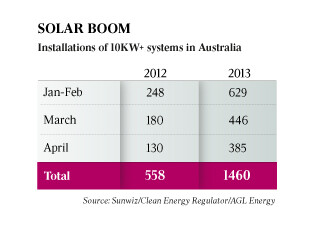As electricity prices rise, more and more Australian businesses have been turning to solar panels to cut their energy bills, with the number of 10 kilowatt (kW) solar systems installed in the first 4 months of 2013 nearly triple those of the previous year, according to figures from Sunwiz and the Clean Energy Council. This boom in commercial solar power installations throughout the country follows on the heels of the similarly unprecedented levels of growth in the residential solar power sector.
Over 1 million Australian homes now have solar PV systems installed. Much of the uptake is attributable to the clear investmentworthiness of going solar under the generous federal and state subsidies that were in place but have since been wound back. In particular, state-based feed-in tariffs made solar power financially attractive in a way that it never was before their introduction. Now, even without these incentives in most states, solar PV installation numbers continue to grow.
As most solar feed-in tariff schemes were designed with residential systems in mind and accordingly had a capacity limitation of around 10kW, generally considered to be the upper limit for residential solar systems and the lower limit for commercial ones. A surge in growth among systems of this size–from 558 in Jan-Apr 2012 to 1,460 in the same period in 2013–is indicative of a sea change in the way that businesses are looking at energy production–and their power bills.
 The shift has certainly not occurred purely as a result of concern for the environment; solar system prices are at historic lows, and electricity prices have risen to historic highs. Once costly, systems have now become so affordable that businesses–especially those who operate through the daylight hours–are working out that it is more affordable to generate their own power than purchase it from the grid. A solar PV system is essentially a rooftop solar power plant.
The shift has certainly not occurred purely as a result of concern for the environment; solar system prices are at historic lows, and electricity prices have risen to historic highs. Once costly, systems have now become so affordable that businesses–especially those who operate through the daylight hours–are working out that it is more affordable to generate their own power than purchase it from the grid. A solar PV system is essentially a rooftop solar power plant.
Solar PV systems of up to 100kW in size are eligible to receive an effective upfront discount on the cost of installation through the federal government’s Renewable Energy Target scheme. This discount has dramatically improved the financial accessibility and attractiveness of solar power across the country.
David Humphries, centre manager for the Windsor Riverview shopping centre Sydney explained the decision to have a 100kW solar system installed there. “We were looking to save money amid rising energy prices and carbon pricing, and there was also the incentive of being seen by the public as a participant in green schemes,” he said in an interview in the Australian. The $250,000 system is expected to pay itself off in 7.5 years, but will continue operating for 25+. Once the system is paid off, the power will cost the system owner almost nothing.
Mr Humphries is not alone in his reasoning. Dick Smith, president of the Macquarie Club in Dubbo, commented about that club’s decision to have a 35kW solar PV system installed: “Our electricity bill was getting unmanageable and we thought it would be a good idea to keep abreast with the times.”
Given that so many are looking to solar to avoid paying for power from the grid, it is not a surprise that utility companies are feeling some pressure. Nino Ficca, managing director at SP AusNet, acknowledged the challenge that distributed solar PV presented to the conventional power industry. The share of SP AusNet customers with solar PV systems increased from 5% to 8% in the space of a year, and the trend is not expected to reverse itself. “Competing infrastructure like solar and storage and electric vehicles may not be on the immediate horizon but we need to start preparing for how we engage with customers on that basis and how we prepare our business so as not to put our head in the sand and pretend it’s not happening,” he said in the Australian article.
© 2013 Solar Choice Pty Ltd
Top photo credit: Amy McIntyre
“Solar Boom” Table source: The Australian
- Solar Power Wagga Wagga, NSW – Compare outputs, returns and installers - 13 March, 2025
- Monocrystalline vs Polycrystalline Solar Panels: Busting Myths - 11 November, 2024
- Solar Hot Water System: Everything You Need to Know - 27 February, 2024